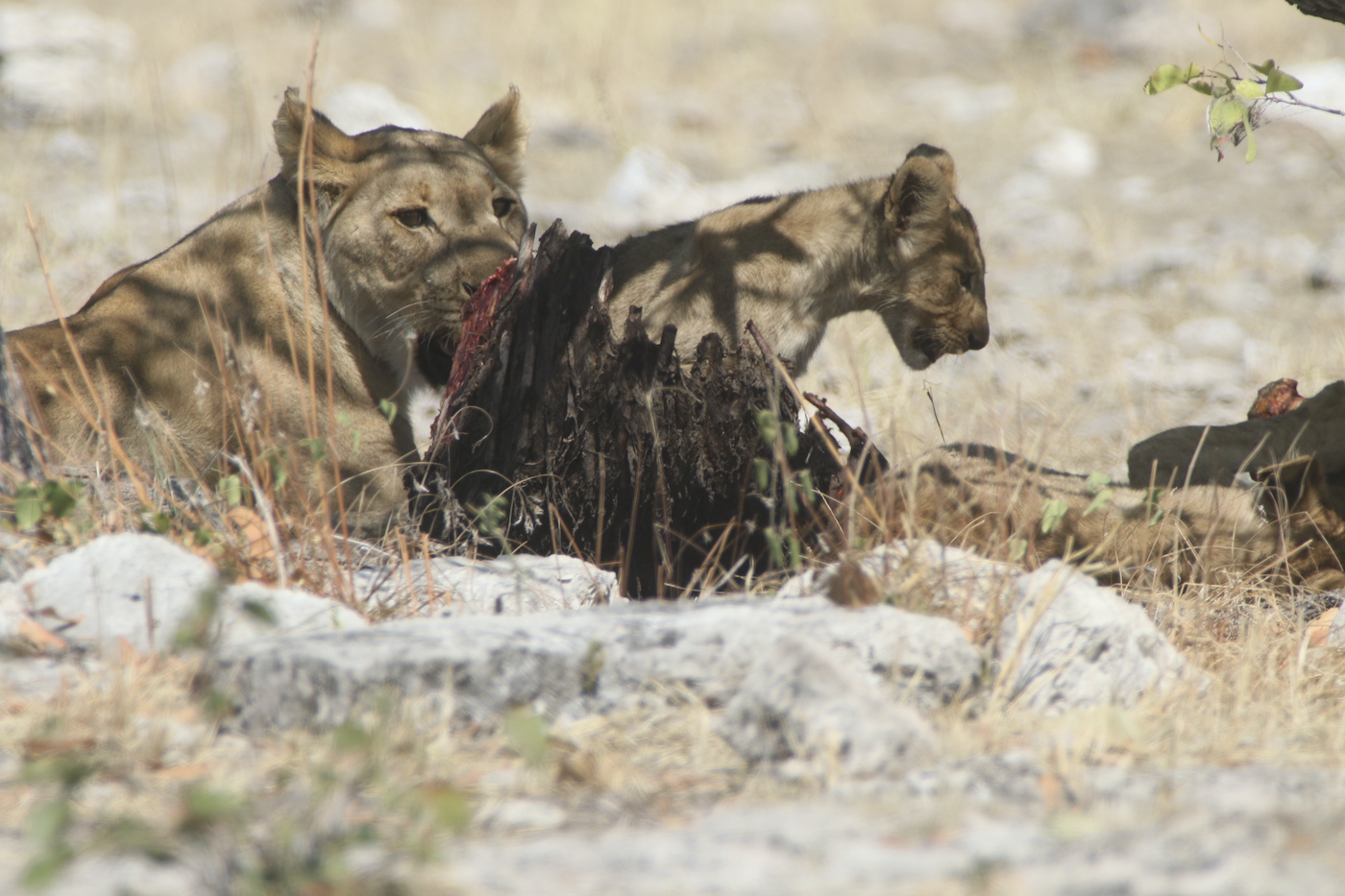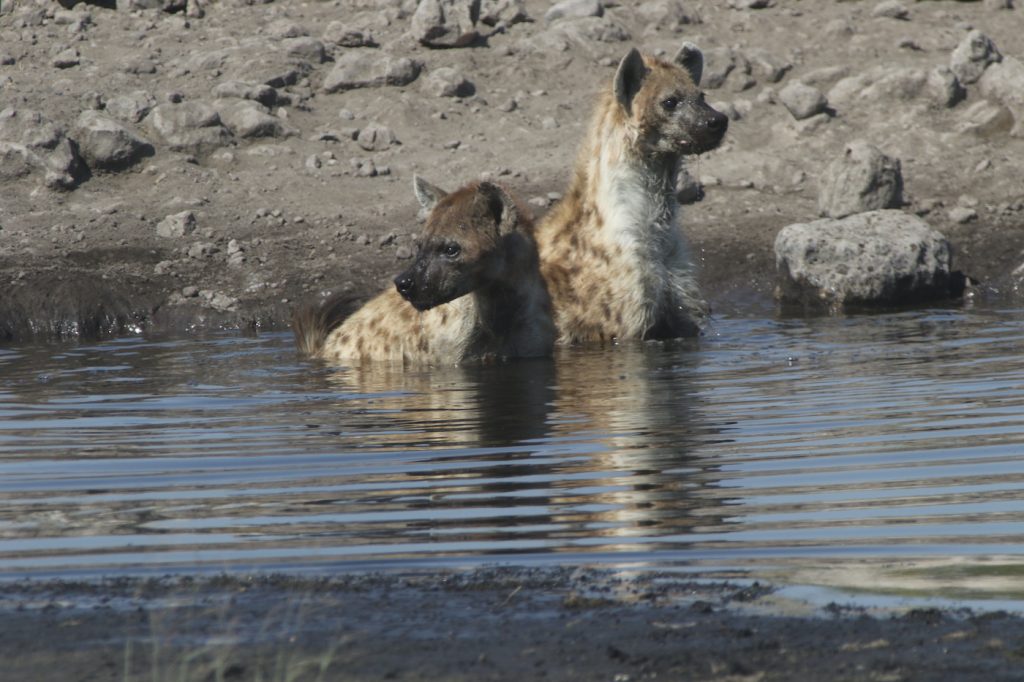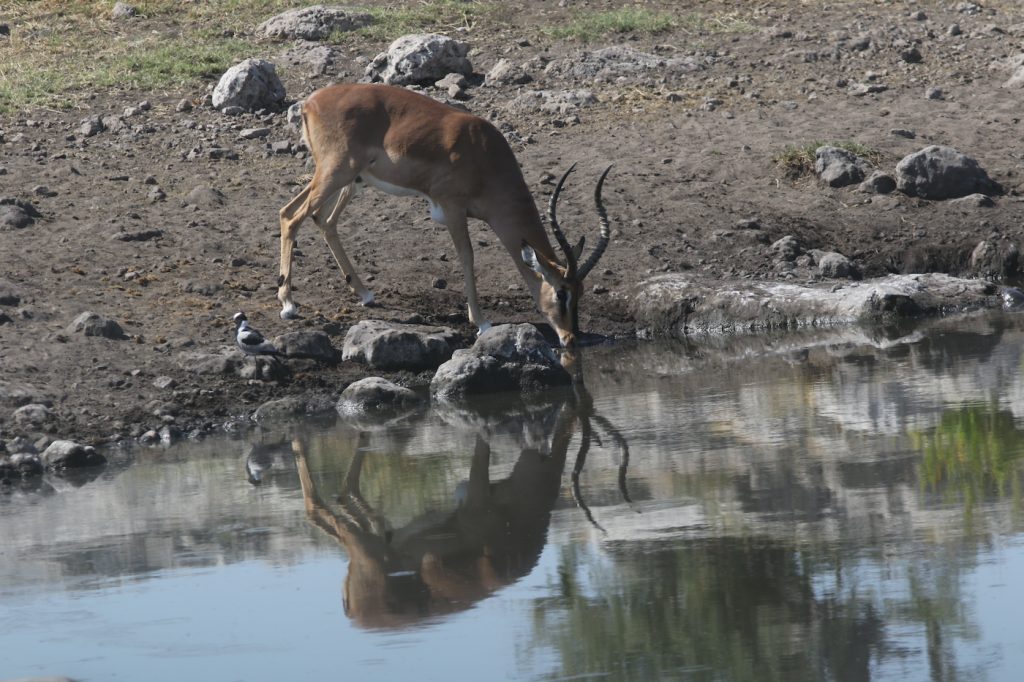Life at the Waterhole

The spotted hyenas soaked themselves in one of the many waterholes surrounding the vast, searing white pan of Etosha National Park in northern Namibia of southwestern Africa.
The two scavengers were multitasking. While cooling off in the shallow pool of water, they were also strategizing on how to drive off a healthy-looking lioness and her four adorable cubs from a day-old zebra kill.
The lioness had pulled the dead zebra into the shade beneath a collapsed tree, but the hyenas were onto her. They could smell the exposed ribs where two of the cubs gnawed on much-needed meat in the middle of the day.
The hyenas and lions were about 150 feet from each other and fully aware of the other’s presence. What species was going to outlast the other?
Desert, Dust, Heat and the African Sun
They all factor in while hanging out at a teeming waterhole. Binoculars on the dashboard, camera in my lap, and Newman’s Birds of Southern Africa resting at my dusty feet, this was my 16th trip to the African continent. While traveling with naturalist Holly Lohuis, if we learned one thing about water in Africa – sooner rather than later, thirsty animals needed to drink. There might not have been anything when we arrived at this waterhole, but sure enough animals eventually emerged. It just took a little patience.

The spotted hyenas weren’t the only animals counting on that water source. From birds like Cape teal, blacksmiths, and an impressive-looking Lanner falcon to herds of plains zebra, springbok, and black-faced impala, everything in the immediate region hovered over the two scheming hyenas.
The hyenas continued to soak and dunked their scruffy heads into the calm pool as droplets of water and drool cascaded off their intense looking faces. Their presence in the waterhole kept all the other thirsty wildlife on edge.
Meanwhile, the lioness with her cubs rested in the shade, the zebra carcass gutted with one of the satiated cubs sprawled out within the exposed rib cage. Maybe another 100 feet away, also in the shade, another lone lioness hunkered down next to another zebra carcass. Both female lions belonged to the same pride.
Unfortunately, the outcome would have to wait. Visitors to Etosha National Park must leave by sunset, but we already knew we’d be back the following morning.
The Tables Turned
When Holly and I returned the next morning, the hyenas had gained the upper hand. There were no lions to be seen, and both zebra carcasses had been removed.
As Holly and I scanned the woody region with our binoculars, we reasoned the lioness with four cubs would’ve prioritized her offspring over the mostly gutted zebra carcass. She would’ve moved away from the carcass with cubs in tow.

After thoroughly scanning the region, we spotted one hyena chasing all wildlife away from the watering hole. Zebras, springbok, black-faced impala, and gemsbok all fled from the water as the lone hyena came in for a mid-morning soak. It was the dominant alpha female. She cooled off for 20 minutes, and then we followed her to where one of the zebra carcasses was. It was being kept safe by four other spotted hyenas.
A couple were feeding on the remaining zebra, three others were napping around it. However, there was no rest for the weary and those scavenging hyenas now had to contend with their own smaller, annoying nemesis – black-backed jackals.
The opportunistic jackals nipped at and snuck within an arm’s length of the powerful jaws of the hyenas only for a chance at a scrap of leftover zebra. As we watched, there were many occasions where the hyenas lunged at the jackals, but the crafty scavengers were too quick.
We never saw the lioness and her four cubs again, but they must’ve been nearby. Every time the hyenas went to the waterhole to drink and soak, they could never fully relax. Their blocky heads we’re on a swivel, constantly watching for the top predator surrounding the Etosha Pan.
As those hyenas soaked the afternoon away, we soaked in all the wildlife, the sights, sounds, and drama hovering around a single waterhole, realizing it was just a small fraction of the vast
desert biome.







You must be logged in to post a comment.